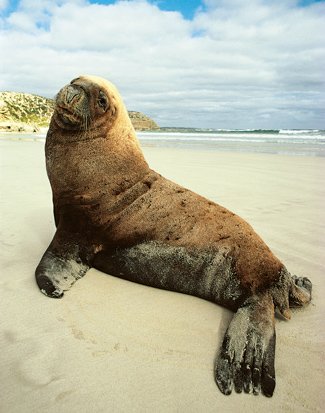Sea lion poo important for ocean health

SEA LION POO may be an important addition to the health of marine ecosystems, according to new research.
The bacteria in an Australian sea lion’s gut keep essential nutrients where they’re most needed in the marine ecosystem, South Australian scientists say.
Researchers from Flinders University in Adelaide studied the bacterial profile of sea lion guts by looking at the entire suite of genes, known as the microbiome. They found the guts contained high numbers of bacteria able to metabolise iron and phosphorus, important elements for growth of the first tier in the marine food chain – phytoplankton.
In order to gather this data the researchers collected faeces from one of the Australian sea lions living in Seal Bay, on Kangaroo Island in South Australia taking care not to contaminate the samples.
In energy-rich environments, such as the surface of sea lion faeces, bacteria are able to release excess nutrients they don’t use for their own growth into the surrounding water, making them available for phytoplankton, the primary producers in the marine ecosystem.
In this way, sea lions may keep nutrients where they can be incorporated into the food chain, says lead author Dr Trish Lavery.
“The bacteria in Australian sea lion faeces may limit nutrient sinkage… and enhance the persistence of nutrients in the photic zone [where there’s sufficient light to support the food chain] where they are available to support primary production by phytoplankton,” says Trish.
Sea lion poo an insight into marine mammals
Dr Tiffanie Nelson from the Australian Institute of Marine Science in Darwin says this research, published in the journal PLoS ONE, is new to the field.
“Currently, there are limited studies which have characterised the gut microbiota of marine mammals and even fewer which detail [their] functional capacity…as this study does,” says Tiffanie. “Marine mammals have been relatively omitted due to the often difficult nature of sampling them. However, marine mammals…are an important addition to understanding the evolution of mammal-host symbioses.”
Tiffanie says studying the microbial interactions of different species provides insight into the evolutionary history of those species.
Sea lion gut bacteria linked to obesity?
Trish believes that her research may also show a link between the microbiome of a species and particular characteristics, in this case obesity. The study showed that sea lion faeces had a ratio of critical bacteria similar to those in obese humans and mice.
She says these bacteria may give sea lions a “predisposition towards the excess body fat”, which is needed to survive in the cold conditions they live in.
RELATED STORIES

